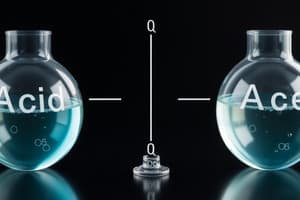Podcast
Questions and Answers
Which characteristic is essential for a molecule to act as an amine base?
Which characteristic is essential for a molecule to act as an amine base?
- The presence of a double bond between nitrogen and hydrogen.
- The ability to form a bond with $OH^-$.
- The ability to donate a proton to water.
- The presence of a lone electron pair on the nitrogen atom. (correct)
What is the role of water in the reaction of a weak base ($B$)?
What is the role of water in the reaction of a weak base ($B$)?
- It stabilizes the $B^+$ ion.
- It donates a proton to the weak base, forming $HB^+$ and $OH^-$. (correct)
- It acts as a catalyst, speeding up the reaction.
- It accepts a proton from the weak base.
What does a high value of $K_b$ indicate about a base?
What does a high value of $K_b$ indicate about a base?
- The base is a strong acid.
- The base is completely un-reactive.
- The base readily reacts with water to form its conjugate acid and $OH^-.$ (correct)
- The base is highly soluble in water.
Which statement accurately describes how $K_b$ is used in calculations involving weak bases?
Which statement accurately describes how $K_b$ is used in calculations involving weak bases?
In the equilibrium-constant expression for weak bases, why is water typically omitted?
In the equilibrium-constant expression for weak bases, why is water typically omitted?
Consider the reaction: $NH_3(aq) + H_2O(l) \rightleftharpoons NH_4^+(aq) + OH^-(aq)$. If the initial concentration of $NH_3$ is 0.20 M and the $K_b$ is $1.8 × 10^{-5}$, which expression correctly approximates the equilibrium concentration of $OH^-$?
Consider the reaction: $NH_3(aq) + H_2O(l) \rightleftharpoons NH_4^+(aq) + OH^-(aq)$. If the initial concentration of $NH_3$ is 0.20 M and the $K_b$ is $1.8 × 10^{-5}$, which expression correctly approximates the equilibrium concentration of $OH^-$?
Which of the following weak bases will produce the lowest concentration of $OH^-$ in a 0.1 M aqueous solution?
Which of the following weak bases will produce the lowest concentration of $OH^-$ in a 0.1 M aqueous solution?
A solution of a weak base has a pH of 10.5. What additional information is needed to calculate the molarity of the base?
A solution of a weak base has a pH of 10.5. What additional information is needed to calculate the molarity of the base?
Why is it important to check the 'x is small' approximation when calculating equilibrium concentrations for weak bases?
Why is it important to check the 'x is small' approximation when calculating equilibrium concentrations for weak bases?
What is the primary reason ammonia ($NH_3$) is classified as a weak base?
What is the primary reason ammonia ($NH_3$) is classified as a weak base?
A chemist discovers a new chemical compound and determines it can accept a proton from water. What further information is needed to determine if the compound is a weak base?
A chemist discovers a new chemical compound and determines it can accept a proton from water. What further information is needed to determine if the compound is a weak base?
Which of the following is true regarding the relationship between a weak base and its conjugate acid?
Which of the following is true regarding the relationship between a weak base and its conjugate acid?
If the pH of an aqueous solution of ammonia ($NH_3$) is 11.0, what is the $pOH$ of the solution at $25^\circ C$?
If the pH of an aqueous solution of ammonia ($NH_3$) is 11.0, what is the $pOH$ of the solution at $25^\circ C$?
What is the correct $K_b$ expression for methylamine ($CH_3NH_2$) in water?
What is the correct $K_b$ expression for methylamine ($CH_3NH_2$) in water?
Using the ICE table method, what algebraic expression represents the equilibrium concentration of $NH_3$ if 'x' is the change in concentration of $NH_4^+$?
Using the ICE table method, what algebraic expression represents the equilibrium concentration of $NH_3$ if 'x' is the change in concentration of $NH_4^+$?
Flashcards
Amine
Amine
A base that removes a proton from a water molecule to form an N-H bond.
Weak Bases
Weak Bases
React with water, accepting protons (H+) from H₂O. This forms the conjugate acid of the base and OH- ions.
Base Dissociation Constant (K)
Base Dissociation Constant (K)
A measure of the extent to which a base reacts with water to form the corresponding conjugate acid and hydroxide ions (OH-).
Necessary for H+ bond
Necessary for H+ bond
Signup and view all the flashcards
Ammonia (NH3)
Ammonia (NH3)
Signup and view all the flashcards
Study Notes
- CHEM 1220 - Chapter 1: Acid-Base Equilibria, focusing on weak bases.
Types of Weak Bases
- Amine defined: A base that the removes a proton from a water molecule, forming an N-H bond.
- A lone electron pair is necessary for the amine to form a bond with H⁺.
Reaction with Water and Dissociation Constant
- Weak bases react with water and extract protons from H₂O
- This forms the conjugate acid of the base and hydroxide (OH⁻) ions.
- The reaction can be represented as: B(aq) + H₂O ⇌ HB⁺(aq) + OH⁻(aq).
- The base dissociation constant (K_b) quantifies the extent to which a base dissociates in water.
- K_b = [HB+][OH-]/[B]
- Water is omitted from the equilibrium-constant expression.
- The most commonly encountered weak base is ammonia (NH₃).
- NH₃(aq) + H₂O ⇌ NH₄⁺(aq) + OH⁻(aq)
Weak Base Examples and Kb Values
- Ammonia (NH₃): K_b = 1.8 × 10⁻⁵
- Pyridine (C₅H₅N):K_b = 1.7 × 10⁻⁹
- Hydroxylamine (HONH₂): K_b = 1.1 × 10⁻⁸
- Methylamine (CH₃NH₂): K_b = 4.4 × 10⁻⁴
- Hydrosulfide ion (HS⁻): K_b = 1.8 × 10⁻⁷
- Carbonate ion (CO₃²⁻): K_b = 1.8 × 10⁻⁴
- Hypochlorite ion (ClO⁻): K_b = 3.3 × 10⁻⁷
- Methylamine produces the highest pH as a 0.05 M solution because it has the highest K_b.
Calculating Hydroxide Concentration
- To calculate the concentration of OH⁻ in a 0.15 M solution of NH₃, start with writing out the K expression
- NH₃(aq) + H₂O ⇌ NH₄⁺(aq) + OH⁻(aq).
- K_b = 1.8 × 10⁻⁵
- Use an ICE (Initial, Change, Equilibrium) table to determine equilibrium concentrations.
- Initial concentrations: [NH₃] = 0.15 M, [NH₄⁺] = 0, [OH⁻] = 0.
- Change in concentrations: [NH₃] = -x, [NH₄⁺] = +x, [OH⁻] = +x.
- Equilibrium concentrations: [NH₃] = 0.15 - x, [NH₄⁺] = x, [OH⁻] = x.
- Substitute the equilibrium concentrations into the K expression: K_b = (x * x) / (0.15 - x) = 1.8 × 10⁻⁵.
- Simplify the equation by assuming x is small, which leads to x² / 0.15 = 1.8 × 10⁻⁵.
- Solve for x: x = √(1.8 × 10⁻⁵ * 0.15) = 1.64 × 10⁻³ M, which represents [OH⁻].
- Since x is less than 5% of 0.15, the simplifying approximation is appropriate.
Determining Molarity from pH
- To determine the molarity of an aqueous NH₃ solution with a pH of 11.17, first determine [OH⁻]
- pOH = 14 - pH = 14 - 11.17 = 2.83
- [OH⁻] = 10^(−2.83) = 1.48 × 10^(−3) M.
- Use an ICE table to relate the initial concentration of NH₃ to the equilibrium concentration of OH⁻.
- Initial concentrations: [NH₃] = x, [NH₄⁺] = 0, [OH⁻] = 0.
- Change in concentrations: [NH₃] = -1.48 × 10^(−3), [NH₄⁺] = +1.48 × 10^(−3), [OH⁻] = +1.48 × 10^(−3).
- Equilibrium concentrations: [NH₃] = x - 1.48 × 10^(−3), [NH₄⁺] = 1.48 × 10^(−3), [OH⁻] = 1.48 × 10^(−3).
- Set up the K expression K_b = [NH₄⁺][OH⁻] / [NH₃] = (1.48 × 10^(−3))² / (x - 1.48 × 10^(−3)) = 1.8 × 10^(−5).
- Simplify: 1.8 x 10⁻⁵x = 2.22 × 10⁻⁶.
- Solve for x: x = 0.12 M.
Studying That Suits You
Use AI to generate personalized quizzes and flashcards to suit your learning preferences.




